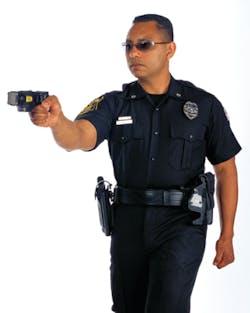The media in my locale recently reported on a man who had been tased by officers for a period of 40 seconds, as if this was cruel and unusual punishment administered by the police. The report stated the individual had been involved in an auto accident in which several vehicles were struck. According to the news, the man was lying on the street in a compliant fashion . . . until he decided to try to run away. Thus, the Taser® deployment.
So what about using the Taser on non-compliant subjects? Have we gone too far in the direction of using the device before exhausting other avenues to gain cooperation and compliance? Should we instead attempt to manually subdue an unruly person, go with the baton, or use a chemical agent?
To put the Taser Conducted Electrical Weapon in perspective, those of you who are old enough can recall pre-Taser days when our go-to weapon was our hands. Encountering uncooperative subjects meant wrestling them to the ground and trying to control them enough until we could put the cuffs on. Sometimes we drew our nightsticks or batons, particularly if our adversary was high on drugs, or perhaps looked like the Incredible Hulk. In other instances, we relied on pepper spray to incapacitate the individual enough so that we could gain compliance. I submit to you that today’s Taser trumps all three previous techniques.
Despite what our egos want us to believe, none of us would last long on the street if we had to employ hand-to-hand combat techniques every time somebody told us, “I’m not goin’ anywhere.” The injuries we’d probably suffer would keep us on the medical far more than would be acceptable. Also, consider the image the public sees when baton strikes are used. More often than not, using the baton results in a complaint of police brutality. Often times baton strikes miss the intended mark, particularly when a resistant subject is moving about.
Similarly, when pepper spray is introduced into a situation, the chemical, particularly if used indoors usually affects more than the intended target. Furthermore, the unintended consequences of baton strikes—serious injuries, bruising and cuts—makes for a difficult defense of the officer, and places the department in a unintended defensive situation.
Enter the Taser, aka, the great equalizer, circa 1998. According to Taser’s statistics, CEWs have been safely deployed more than 3 million times. Since the Taser devices also operate as computers that collect and store data on each use, there’s no reason to doubt that number. But heck, that’s a lot of non-compliant subjects!
Despite the visual imparted when a subject is being tased, and there are plenty of videos circulating on the internet depicting Taser incidents, the result is that the subject stops resisting and the officers can safely handcuff the prisoner. In many instances, the Taser doesn’t even need to be deployed. The mere threat of being tased is sufficient to gain cooperation. But using a CEW is not only much safer than batons and chemicals, but it brings an incident to a much speedier conclusion.
Myriad studies have been conducted concerning the efficacy of the Taser, particularly regarding the safety aspect. A 2010 DOJ study, A Multi-Method Evaluation of Police Use of Force Outcomes: Final Report to the National Institute of Justice, resulted in the following conclusions:
- 12 agencies had more than 24,000 use of force cases. When the Taser was used, the odds of a suspect becoming injured decreased by almost 60%.
- Death from being pepper sprayed or tasered is very rare, and no clear evidence exists that the weapons themselves caused the deaths.
A five-year study by the National Institute of Justice panel of 114 medical experts and doctors concluded that:
- Research does not support an increased risk of cardiac arrhythmia, even if darts strike the front of the chest.
- All evidence suggests the use of the device carries a risk as low or lower than most alternatives.
- CEWs are associated with a significantly lower risk of injury than physical force, and should be considered as an alternative.
It should be noted that LE spends approximately $2.5 billion annually on litigation. That number, in my opinion, would be even higher were it not for the Taser. Police work is inherently dangerous and risky. We deal with people during episodes of aberrant behavior. Most times unpredictability is the only thing predictable. To be able to have a standoff tool such as the Taser is priceless.
I posed this question earlier: Have we gone too far in the direction of using the device before exhausting other avenues to gain cooperation and compliance? I submit that we’re right where we need to be, particularly when we see the decline of officer injuries in non-compliant arrests when using CEWs. The Taser isn’t about pain compliance. Instead, the Taser uses Neuro Muscular Incapacitation to stop coordinated movement to provide a window of opportunity for the officer(s) to gain control. The Taser has proven to be the new go-to weapon for those who choose to resist.
To tase, or not to tase? The answer is clear.
Stay Safe, Brothers and Sisters.

John Wills
John M. Wills is a former Chicago police officer and retired FBI agent. He is a freelance writer and award-winning author in a variety of genres, including novels, short stories and poetry. John also writes book reviews for the New York Journal of Books, and is a member of the National Book Critics Circle. His new book, The Year Without Christmas, is available now. Visit John at: www.johnmwills.com.



